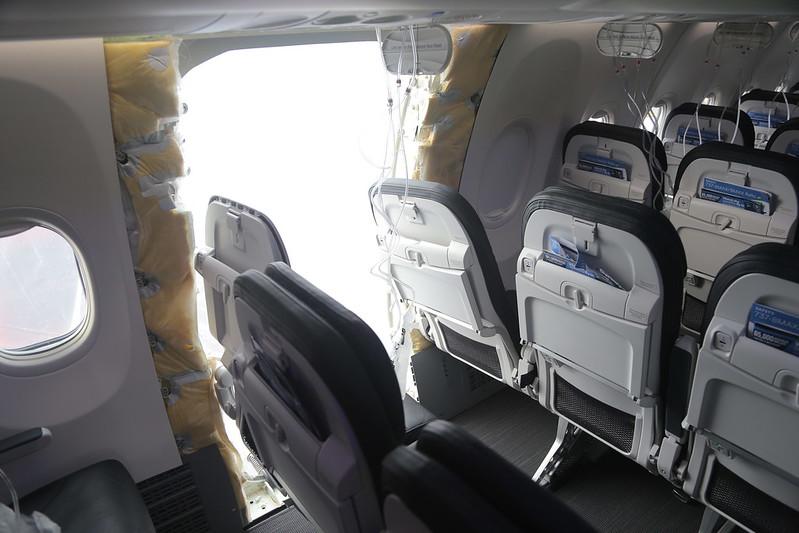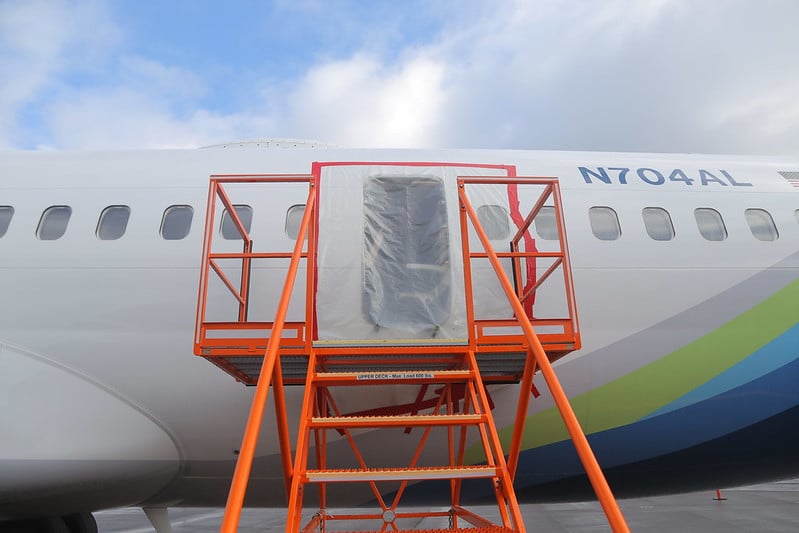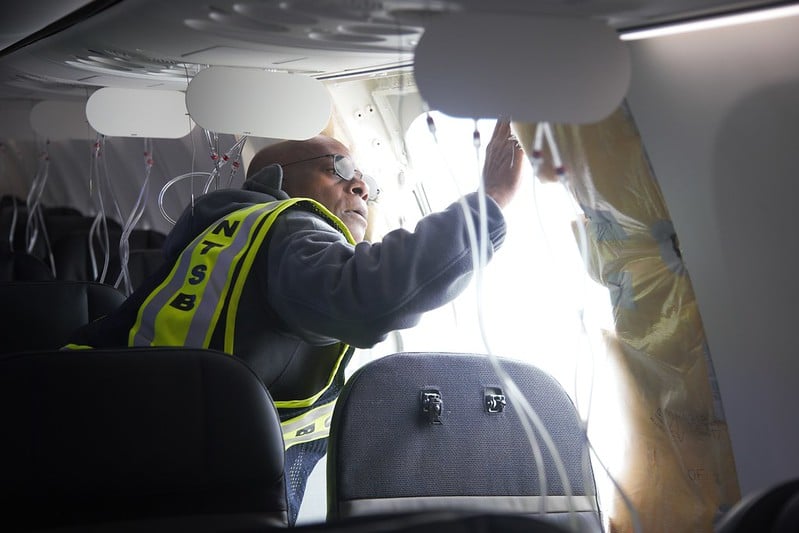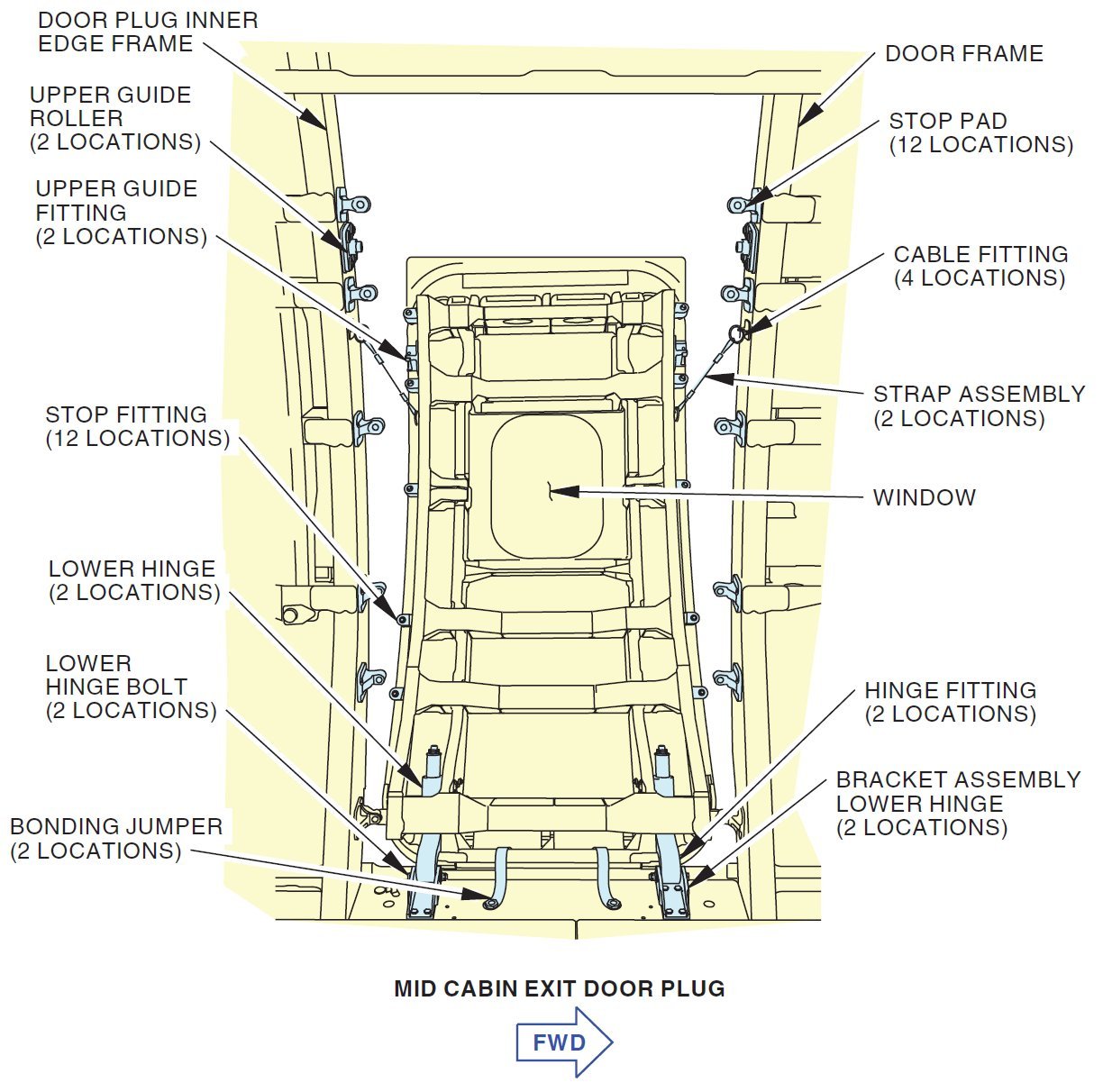FAA Grounds, Orders Immediate Inspections Of Most Boeing 737-9s

A photo released by NTSB shows the Alaska Airlines 737-9 missing the fuselage plug and window section in the deactivated left-hand mid-emergency door.
The FAA has ordered immediate inspections of certain Boeing 737-9s following the Jan. 5 inflight loss of an insert covering a door-sized space in the fuselage for an optional emergency exit during an Alaska Airlines flight.
Meanwhile, the door "plug" that detached from the aircraft has been found as part of an investigation into the incident, NTSB Chair Jennifer Homendy said Jan. 7. In a late briefing Homendy said NTSB is looking into an auto-pressurization fail light on board that had illuminated three times in recent weeks.
A Jan. 6 emergency airworthiness directive (EAD) orders immediate inspections of aircraft with the inserts, or plugs, that deactivate the exits. The EAD provides few details on the issue or its cause. It says the mandatory checks are necessary following "a report of an in-flight departure of a mid-cabin door plug, which resulted in a rapid decompression of the airplane."

The FAA in a statement said the EAD covers 171 of the 218 737-9s delivered by Boeing to date. The checks apply to 737-9s with plugs that have not yet reached 4,000 cycles, sources with knowledge of the issue tell Aviation Week. The cycle limit is linked to a threshold for routine inspections of the affected area, the sources said.
Inspections will take up to 8 hr. per aircraft, the agency said.
Boeing is developing recommended inspection protocols to comply with the directive. Once the agency reviews and approves them, operators can start inspecting aircraft, United Airlines said in a Jan. 7 update. United said it is preparing for the checks by removing interior panels to prepare aircraft for checks. United has 79 737-9s and all of them need the checks.
The European Union Aviation Safety Agency immediately adopted FAA's directive for affected European aircraft.
“The FAA is requiring immediate inspections of certain Boeing 737 MAX 9 planes before they can return to flight,” FAA Administrator Mike Whitaker said.
Boeing in a statement said it supports the FAA's decision "to require immediate inspections of 737-9 airplanes with the same configuration as the affected airplane."
Alaska opted to ground and inspect its entire Boeing 737-9 fleet following the Jan. 5 occurrence, which took place on a flight from Portland, Oregon, to Ontario, California.
Flight 1282 departed at 4:52 p.m. PST. About 10 min into the flight as the aircraft was climbing through FL160 (16,000 ft.), a fuselage "plug" covering the gap where an optional emergency exit fits broke free. The aircraft experienced a rapid decompression. The flight crew declared an emergency and returned to Portland where the aircraft, with 171 passengers and six crew, landed safely.
NTSB Update
In weekend briefings Homendy confirmed the basic event timeline and provided a few new details. She confirmed that the two seats next to the ruptured plug were not occupied at the time of the accident.
The unoccupied seats and timing of the event—during climb, when passengers are often seated and belted in, instead of during cruise, when both passengers and cabin attendants are moving around—minimized the risk, Homendy suggested. Another lucky element in the accident sequence: the departing plug did not strike any part of the airframe or tail assembly.
An NTSB team spent Jan. 7 documenting damage, deformation and witness marks on the left plug surround structure in situ, Homendy said. The team took photos and examined witness marks looking for paint transfer and identified the components they want to send back to the lab for further evaluation.

“They’ll look for fractures, they’ll look at more paint marks, if anything was sheared or if there was any deformation they may be able to see it better under the microscope,” she said.
The team also plans to look at the door plug that remains intact in the fuselage.
The NTSB wants to look more closely at auto-pressurization fail light that illuminated on three previous flights in December and January.
Those three events were reported as “benign” occurrences by the airline, Homendy said. Further maintenance work to look into the light had been planned but not yet carried out by the time of the Jan. 5 incident. An E-TOPS restriction had been put in place preventing the aircraft being used on routes to Hawaii over the water so that it could return quickly to an airport if the light came on again.
The NTSB has requested documentation of any maintenance carried out on the aircraft since it was delivered in October.
“We will want to look into that system further,” Homendy said. "It’s certainly a concern and one we want to dig into and look at what occurred there and if there is any relation at all or correlation on this event, we don’t know that at this time. It may have nothing to do with the auto-pressurization system, it could be something just wrong with the light.”
The NTSB has sent the aircraft’s flight data recorder and cockpit voice recorder to its lab but has established that the CVR was completely rewritten so will not provide any information for the investigation.
After the end of the late Jan. 7 briefing Homendy returned to disclose that the plug had been found.
A schoolteacher named Bob from Portland, Oregon, found the door plug in his backyard and sent in photos to the NTSB, Homendy said. NTSB would soon begin analyzing what had been a key missing component of the investigation, she said.
"We have the safest aviation system in the world," Homendy said. "We are the global gold standard for safety around the world. But we have to maintain that standard. We are very, very fortunate here that this didn't end up in something more tragic."
Plug Configuration
Photos released by NTSB show the aircraft is missing the fuselage plug and window section in the deactivated left-hand mid-emergency door (MED), sometimes referred to as a mid-exit door. The 737-9 has two of these Type 1 MEDs, each measuring 26 x 51 in., located aft of the trailing edge of the wing on the left and right sides of the fuselage.
When activated, the additional emergency exit doors enable higher-capacity configurations for up to 220 passengers. However, as Alaska does not operate the 737-9 in these denser seating arrangements, the MED exits are blocked off with plugs to save weight. The plug configuration limits capacity to 189 passengers; Alaska's 737-9s have 178 seats.
The plug configuration—one of two options Boeing offers to deactivate MED exits on a 737-9—incorporates a standard window and is concealed behind a cabin interior sidewall panel section.
The plugs and surrounding fuselage section are supplied by Spirit AeroSystems, which remains under scrutiny for numerous production-quality lapses on 737 and 787 subassemblies—its two largest programs.

United Airlines also operates 737-9s with the blocked exits and is affected by the FAA order.
Boeing said it is in communication with Alaska and gathering more information. It is supporting the NTSB's probe.
Before the FAA's mandate, Alaska said each of the 65 affected aircraft would undergo full maintenance and safety inspections, which the carrier expects will be complete “in the next few days," CEO Ben Minicucci said in a statement.
“We are working with Boeing and regulators to understand what occurred tonight, and will share updates as more information is available,” he added.
Alaska reviewed its maintenance records said 18 of its 737-9s had undergone routine, scheduled inspections that included examinations of the plug assembly before the in-flight occurrence. The airline initially cleared those aircraft in service, but removed them when the FAA order was issued.
"These aircraft have now also been pulled from service until details about possible additional maintenance work are confirmed with the FAA," the airline said Jan 6. "We are in touch with the FAA to determine what, if any, further work is required before these aircraft are returned to service."
The aircraft involved, N704AL, was delivered on Oct. 31, 2023, the Aviation Week Network Fleet Discovery database shows. It had operated 134 cycles through Dec. 31, according to Fleet Discovery's Tracked Aircraft Utilization, including 79 in December.
The 737-9 variant, the second of the re-engined 737 Next Generation family to enter service, completed its first flight on April 13, 2017. Most of the 218 737-9s in service are with United and Alaska.
United said that 33 of its 737-9s have already had the required inspection. It was the first North American carrier to operate the variant, in June 2018, and operates many of the highest-time airframes.
Turkish Airlines said it removed five affected 737-9s "until the technical investigation process is completed and the measures requested by the authorities are implemented," a spokesperson said.
FlyDubai confirmed that its three aircraft are not affected because they do not have the blocked exit plug configuration.
Other operators with substantial numbers of 737-9s with deactivated exits include Copa Airlines (29), Aeromexico (18), Fleet Discovery shows.
Panama-based Copa said Jan. 6 that it had temporarily suspended operations of 21 737-9s until the aircraft could undergo inspections based on the FAA EAD. Copa said it had initiated the technical inspections and expected to return the aircraft “safely and reliably to the flight schedule within the next 24 hours.”
With reporting from Kurt Hofmann.
Editor's note: This article has been updated with additional details.








